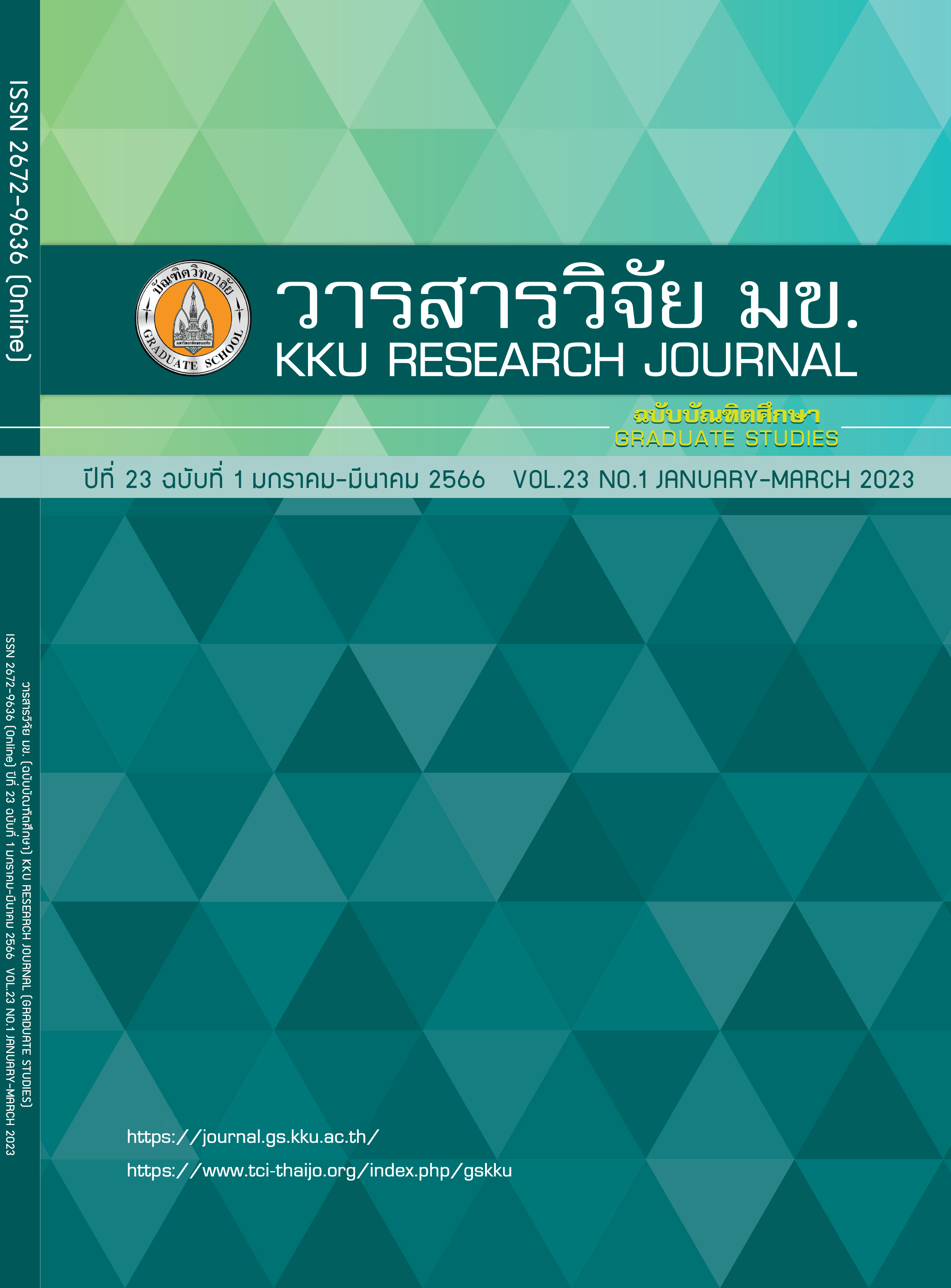Prioritization of Suitable Measures for Traffic Management Scheme on A Collector Road in Khon Kaen University
Keywords:
Hybrid Multi-Attribute Decision Making (HMADM), Environmental Adaptation Method (EAM), Khon Kaen UniversityAbstract
This paper presents the prioritization of appropriate traffic management measures along a collector road in front of the complex building in Khon Kaen University. The study applied Hybrid Multiple-Attribute Decision Making (HMADM) based on the Sustainable Development (SD) principles and the Environmental Adaptation Method (EAM) for such prioritization. The results of prioritizing measures are as follows: the top three measures for the transition zone are are raised pavement at the intersection (0.664), visibility (0.655) and speed hump (0.653). For the core zone, the three top ranking measures are mid-block crossing (0.736), railing footpath and median (0.688) and street lighting (0.679). The above measures are consistent with the measures that were implemented in the study area.
References
Strategy Division Khon Kaen University. Khon Kaen University Statistic Report. 2020.
World Health Organization. Global status report on road safety: time for action. Geneva, Switzerland; 2009.
World Health Organization. Global status report on road safety 2013: supporting a decade of action. Geneva, Switzerland; 2013.
World Health Organization. Global status report on road safety 2015. Geneva, Switzerland; 2015.
World Health Organization. Global status report on road safety 2018. Geneva, Switzerland; 2018.
Department of disease control. Report 2010-2020 year on Road Accident from Integrated Database. 2021.
OECD. Towards Zero: Achieving Ambitious Road Safety Targets through a Safe System Approach. Paris; 2008.
Roads and Traffic Authority. Sharing the Main Street. 2000; Available from: http://scholar.google.com/scholar?hl=en&btnG=Search&q=intitle:Sharing+the+main+street#8
Brindle BE. Traffic calming in Australia. A definition and commentary. Aust road Res. 1991;21(2):37–55.
HASS-KLAU C. A GERMAN LESSON IN TRAFFIC CALMING. London; 1992.
Pharaoh TM, Russell JRE. Traffic Calming Policy and Performance: The Netherlands, Denmark and Germany. Town Plan Rev [Internet]. 1991 Feb 16;62(1):79–105. Available from: http://www.jstor.org/stable/40112985
Klungboonkrong P, Taylor MAP. The experiences in evaluating the multicriteria traffic environmental impacts in urban road networks using SIMESEPT. Adv Transp. 2002;311–322.
Klungboonkrong P, Taylor MAP. An integrated planning tool for evaluating road environmental impacts. Comput Civ Infrastruct Eng. 1999;14(5):335–345.
Gilman C. Shared-Use Streets – An Application of “Shared Space” to an American Small Town. In: 3rd Urban Street Symposium. Seattle, Washington; 2007.
Pengpeng L, Xu C. Campus Traffic Calming: A Case Study of Xipu Campus, Southwest Jiaotong University. J Landsc Res. 2017;9(6):33–38.
Klungboonkrong P, Woolley JE. Modelling the Environmental Adaptation of a Collector Road in a Area of High Pedestrian Activity in the City of Khon Kaen. Transp Eng Aust. 2003;9(1):25–34.
Klungboonkrong P, Bejrananda M, Faiboun N. The Application of the Environmental Adaptation Concept to A Collector Road in KKU, Thailand. J Sci Technol Mahasarakham Univ. 2016;35(3):280–288.
Newman P, Kenworthy JR. Sustainability and cities: overcoming automobile dependence. Washington, D.C.: Island Press; 1999.
United Nation. The sustainable development goals report 2016. New York; 2016.
Guegan DP, Martin PT, Cottrell WD. Prioritizing Traffic-Calming Projects Using the Analytic Hierarchy Process. Transp Res Rec J Transp Res Board. 2000 Jan 1;1708(1):61–67.
Falamarzi A, Cheraghi S, Mahmoudian A. Using a fuzzy group TOPSIS model for prioritising and selecting traffic calming measures in residential streets. In: ATRF 2017 - Australasian Transport Research Forum 2017, Proceedings. 2017.
Chen S-J, Hwang C-L. Fuzzy Multiple Attribute Decision Making. Berlin, Heidelberg: Springer Berlin Heidelberg; 1992. (Lecture Notes in Economics and Mathematical Systems; vol. 375).
Klungboonkrong P. Development of a decision support tool for the multicriteria environmental impact evaluation of urban road networks. University of South Australia; 1998.
Saaty TL. How to make a decision: The analytic hierarchy process. Eur J Oper Res. 1990 Sep;48(1):9–26.
Torbic DJ, Gilmore DK, Bauer KM, Bokenkroger CD, Harwood DW, Lucas LM, et al. Design Guidance for High-Speed to Low-Speed Transitions Zones for Rural Highways. Washington, D.C.: Transportation Research Board; 2012.
Klungboonkrong P. Sustainable Urban Transportation Planning: Principle and Practice. Faculty of civil engineering KhonKaen University; 2018.
South Carolina Department of Transportation. Traffic calming guidelines. 2006.
Saaty TL. The Analytic Hierarchy Process. Decision Analysis. 1980.
Rodriguez R. Models, Methods, Concepts and Applications of the Analytic Hierarchy Process. (Book Reviews). Interfaces (Providence). 2002 Feb 16; 32:93.
Chen SH. Ranking fuzzy numbers with maximizing set and minimizing set. Fuzzy Sets Syst. 1985;17(2):113–129.
Micale R, La Fata CM, La Scalia G. A combined interval-valued ELECTRE TRI and TOPSIS approach for solving the storage location assignment problem. Comput Ind Eng. 2019 Sep;135:199–210.
Nuthpahong P, Klungboonkrong P, Faiboun N, Waisurasingha C, Pramualsakdikul S, Bejrananda M. The selection of Transit Oriented Development (TOD) locations along Light Rail Transit (LRT) Route using the integration of Analytic Hierarchy Process (AHP), Fuzzy Scoring Method (FSM) and Simple Additive Weight (SAW) [In Thai]. KKU Res J (Graduate Stud. 2020;20(2 April-June).
Downloads
Published
Issue
Section
License
Copyright (c) 2023 KKU Research Journal (Graduate Studies)

This work is licensed under a Creative Commons Attribution-NonCommercial-NoDerivatives 4.0 International License.



